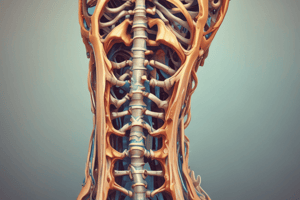Podcast
Questions and Answers
The Vertebral Column primarily provides stability to the body.
The Vertebral Column primarily provides stability to the body.
True (A)
Plasticity in the context of the Vertebral Column refers to the ability of the ligaments to stretch without breaking.
Plasticity in the context of the Vertebral Column refers to the ability of the ligaments to stretch without breaking.
False (B)
The function of rigidity in the Vertebral Column is similar to that of a ship's sail.
The function of rigidity in the Vertebral Column is similar to that of a ship's sail.
False (B)
At shoulder level, the Vertebral Column supports a main-yard set vertically.
At shoulder level, the Vertebral Column supports a main-yard set vertically.
The muscular tighteners in the Vertebral Column automatically adapt their tension to maintain rigidity and stability.
The muscular tighteners in the Vertebral Column automatically adapt their tension to maintain rigidity and stability.
The plasticity of the Vertebral Column allows for changes in its shape without affecting its rigidity.
The plasticity of the Vertebral Column allows for changes in its shape without affecting its rigidity.
The vertebral column provides a base of support for the head and internal organs.
The vertebral column provides a base of support for the head and internal organs.
There are 22 intervertebral disks in the vertebral column.
There are 22 intervertebral disks in the vertebral column.
The cervical region of the vertebral column has 5 distinct vertebrae.
The cervical region of the vertebral column has 5 distinct vertebrae.
The thoracic region of the vertebral column has 10 distinct vertebrae.
The thoracic region of the vertebral column has 10 distinct vertebrae.
The sacral region of the vertebral column has fused vertebrae.
The sacral region of the vertebral column has fused vertebrae.
Curves with a posterior convexity in the sagittal plane are known as lordotic curves.
Curves with a posterior convexity in the sagittal plane are known as lordotic curves.
The secondary curves of the vertebral column in a baby are kyphotic.
The secondary curves of the vertebral column in a baby are kyphotic.
The vertebral body is built like a long bone with a dense bony cortex surrounding a spongy bone.
The vertebral body is built like a long bone with a dense bony cortex surrounding a spongy bone.
The pedicles divide the vertebral arch into two parts.
The pedicles divide the vertebral arch into two parts.
The articular processes are located behind the laminae in a typical vertebra.
The articular processes are located behind the laminae in a typical vertebra.
The vertebral body has discal surfaces consisting of thin cortical bone.
The vertebral body has discal surfaces consisting of thin cortical bone.
The vertical trabecular systems within the spongy bone help to resist compression forces.
The vertical trabecular systems within the spongy bone help to resist compression forces.
Area of strengthness is found in the anterior portion of the body.
Area of strengthness is found in the anterior portion of the body.
Stability of the spine is maintained by three columns.
Stability of the spine is maintained by three columns.
The resistance R of a curved column is inversely proportional to the number N of curvatures + 1.
The resistance R of a curved column is inversely proportional to the number N of curvatures + 1.
The Delmas index is quantified as H/L x 100, where H is the height of the spinal column from the upper surface of S1 to the atlas.
The Delmas index is quantified as H/L x 100, where H is the height of the spinal column from the upper surface of S1 to the atlas.
Area of weakness in the body is not associated with a potential collapse of the vertebrae.
Area of weakness in the body is not associated with a potential collapse of the vertebrae.
The spinal curvatures decrease resistance to axial compression forces.
The spinal curvatures decrease resistance to axial compression forces.
The major column in the spine is located posteriorly and made up of articular processes.
The major column in the spine is located posteriorly and made up of articular processes.
Mobility is directly quantified by the Delmas index expressed as L/H x 100.
Mobility is directly quantified by the Delmas index expressed as L/H x 100.
Flashcards are hidden until you start studying




